Assault on the U Line (U-asema)
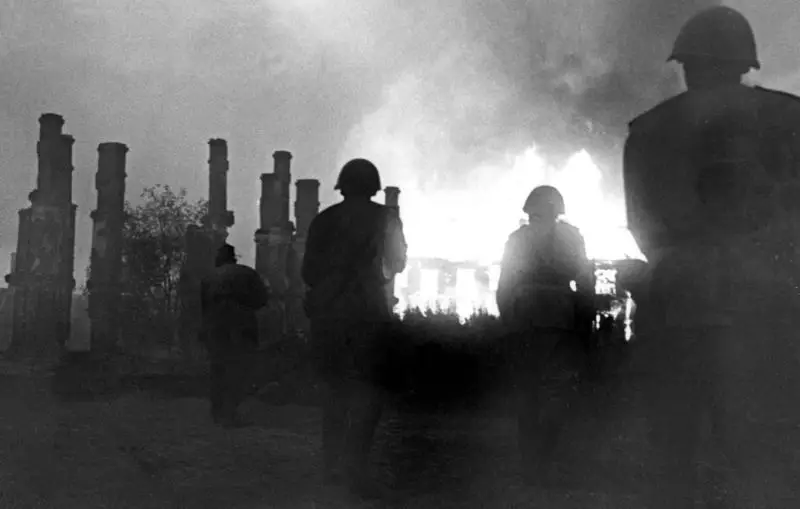
This article is a logical continuation of the previous one Articles “Finnish defensive lines, lines of long-term fortifications. Line U (U-asema)” and tells about the assault by Soviet troops on the Finnish line of fortifications, called Line U (U-asema).
In addition, in the opinion of the authors, the historical events, namely the assault on a long-term line of defense, combining both field fortification structures and long-term ones, in terms of: organizing reconnaissance activities; organizing the interaction of units and subunits, as well as types and branches of troops; communications and target designation; engineering preparation of assault operations may be interesting in the light of a new approach to defensive lines in general. This refers to the so-called “Surovikin Line”, which has already played its role in the Northern Military District, and its antipodes on the Ukrainian side.
Objectives of the operation or from strategy to tactics
By the summer of 1944, the Soviet command had developed plans for several strategic operations both against, primarily, German troops and Finnish ones. However, one should not assume that by 1944 there were enough resources and reserves for the entire multi-kilometer front line and the implementation of these plans. It was necessary to free them. Thus was born the plan for the Vyborg-Petrozavodsk strategic offensive operation (June 10 - August 9, 1944).
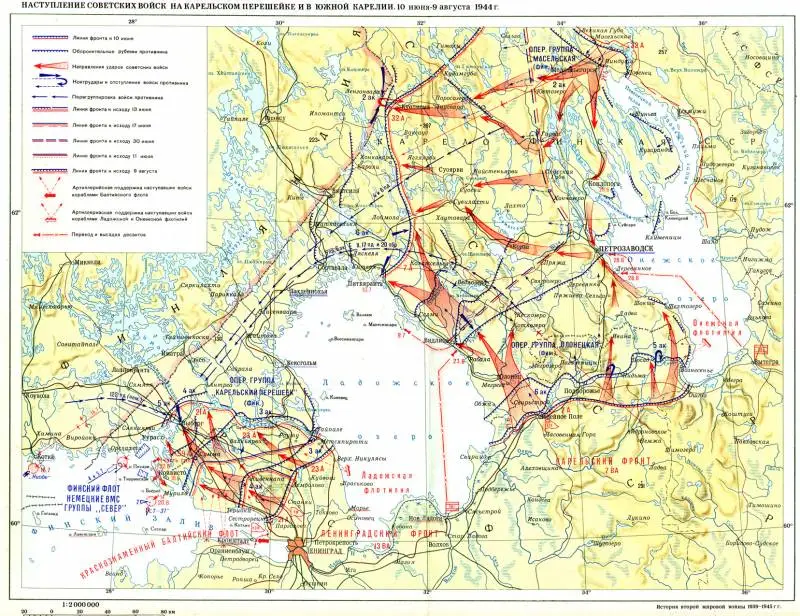
The purpose of this operation was to defeat the Finnish army, reach the state border and withdraw Finland from the war, in addition, this would free up the forces that were supposed to participate in Operation Bagration (looking ahead, let’s say that this is primarily the 37th Guards rifle corps, which also consisted of paratroopers of the 98th and 99th Guards Rifle Divisions, and in this sense, the participation of the modern 98th Guards Airborne Svir Red Banner, Order of Kutuzov Division named after the 70th anniversary of the Great October Revolution in offensive operations during SVO seems all the more symbolic to us).
The idea was to use powerful blows from the troops of the Leningrad (commander - Marshal of the Soviet Union L. A. Govorov) and Karelian (commander Army General K. A. Meretskov) fronts with the assistance of the forces of the Baltic fleet and the Ladoga military flotilla to defeat the opposing group of Finnish troops, capture Vyborg, Petrozavodsk, reach the Ilomantsi, Sortavala, Kotka line, liberate the territory of the Karelo-Finnish SSR and the northern part of the Leningrad region and restore the state border with Finland.
First, the troops of the Leningrad and then the Karelian Front were supposed to go on the offensive. As already mentioned, it was necessary to act against the Finnish army with limited forces and means. Meanwhile, by the summer of 1944, the Finnish command sought to maintain its positions on the Karelian Isthmus and South Karelia, relying on the main forces of the Finnish army - the Maselskaya, Olonetskaya and Karelian Isthmus operational groups. They consisted of 18 divisions, 280 thousand people, 3 guns and mortars, 200 tanks and 270 aircraft.
Using numerous lakes, rivers, swamps, forests, granite rocks and hills, the Finnish troops created a strong, well-equipped defense with a depth of 120 km on the Karelian Isthmus and up to 180 km in South Karelia, full of long-term (including reinforced concrete) ) fire structures. The Soviet troops in southern Karelia and on the Karelian Isthmus did not have a significant advantage over the enemy in manpower, significantly superior to him only in tanks, artillery and aviation. In southern Karelia, the 7th and 32nd armies before the start of the operation were inferior in strength to the Finnish group of forces “Olonets” under Lieutenant General Talvela.
The operation was carried out by forces of two fronts: the attack was carried out by two armies of the right flank of the Leningrad Front (21st and 23rd armies), on the left flank of the Karelian Front the 7th and 32nd armies operated, which went on the offensive 10 days after the start of active actions of the Leningrad Front on the Karelian Isthmus (thus, this operation is divided into the Vyborg (June 10–20) and Svir-Petrozavodsk (June 21–August 9) operations).
It was the difference between the attacks of 10 days that should have led to the weakening of the Finnish troops in southern Karelia, so the Headquarters decided to postpone the start of the operation to force the river. Svir with units of the 7th Army, expecting the transfer of significant enemy forces from southern Karelia to the Karelian Isthmus. And this is a definite plus for our command. This technique of dispersing the enemy’s defending forces should be repeated in modern warfare.
Since consideration of further events on the Karelian Isthmus is not the purpose of this article, we will describe them briefly.
After the breakthrough on June 14 by the 109th Rifle Corps of the second defensive line of the Finns Vammelsuu - Taipale (VT-asema) in the area of the village of Kuuterselka, operational space opened up for the 21st and 23rd armies to quickly reach the intermediate line Lappeenranta - Vyborg to develop success towards Helsinki. The headquarters of the Leningrad Front did not consider the rear defensive line of the Finns Vyborg - Kuparsaari - Taipale (VKT-asema) to be a serious obstacle, therefore, assessing the situation similarly, on June 15, the Commander-in-Chief of the Finnish Army, Marshal K. G. Mannerheim ordered units of the Olonets group of forces to withdraw to the line r . Svir is ready for further retreat.
To strengthen the troops on the Karelian Isthmus, almost half of the troops were hastily transferred from South Karelia, as the Supreme High Command Headquarters had expected: 4 infantry divisions, 1 infantry brigade and one corps command. This strategic maneuver gave the Finnish command the opportunity to stabilize the situation on the Karelian Isthmus (this is a renunciation of offensive actions and a transition to the defense of the troops of the Leningrad Front on the Karelian Isthmus near the village of Ihantala and in the Vuosalmi area until the end of hostilities on September 4–5, 1944).
Predicting the suspension of the offensive on the Karelian Isthmus, the Supreme High Command Headquarters decided to achieve success in the direction of Sortavala and Loimola with the subsequent withdrawal of our troops deep into Finland, then, after capturing the city of Sortavala, the regrouped troops of the Leningrad Front operating on the Karelian Isthmus were to go on the offensive. Well, this is also a plus in the treasury of military art - having not achieved success or having lost the strike potential, reorient forces and use success in another direction.
So from questions of strategy we smoothly move on to questions of tactics.
Assault on the U Line (U-asema)
By July 10, 1944, after crossing the Svir River, breaking through the Finnish defensive line at the Obzha-Sarmyagi-Sambatux (PSS-asema) line, the battles for Olonets and, having carried out the Tuloksinsky landing operation with the forces of the Ladoga military flotilla, the main forces of the strike group of the 7th Army left to the rear defensive line of the Finnish army (U-asema) in the Pitkäranta, Loymola sector after units of the 4th Rifle Corps of Major General P.V. Gnedin captured the city of Pitkäranta.
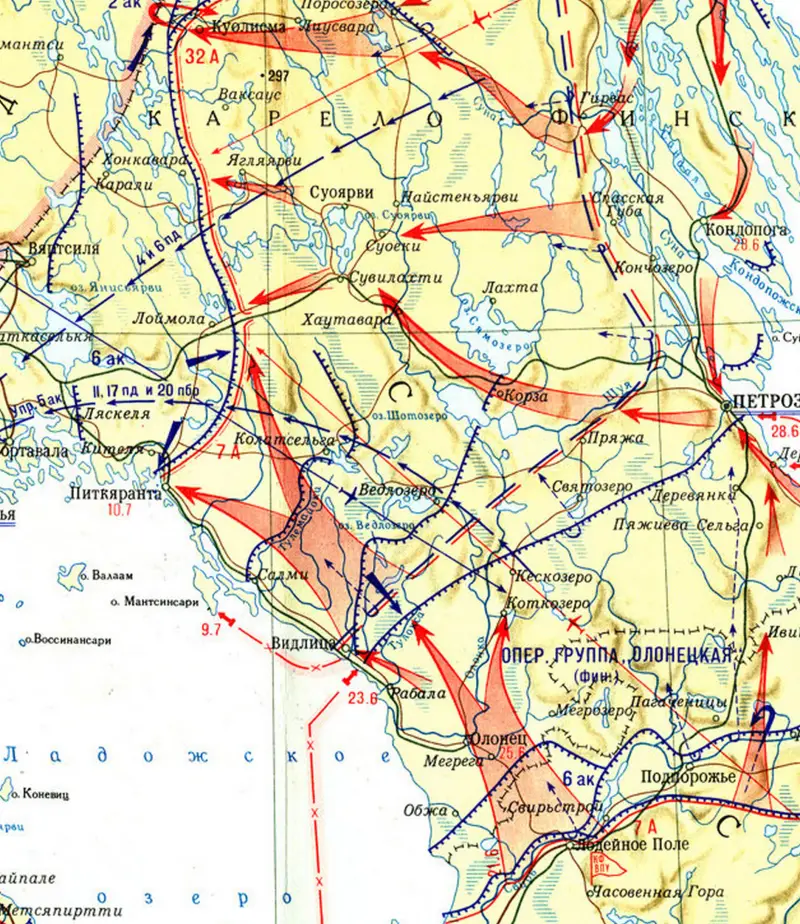

The Red Army soldiers enter the city of Pitkäranta (translation from Finnish - long shore), set on fire by the retreating Finnish troops.
This 55-kilometer defensive line was not completed by the summer of 1944; there were up to 25 bunkers, 12 concrete pillboxes, full-profile trenches and wire barriers along the entire defense line. Anti-tank obstacles and minefields were built in tank-dangerous directions (we wrote about this in full in the previous article).
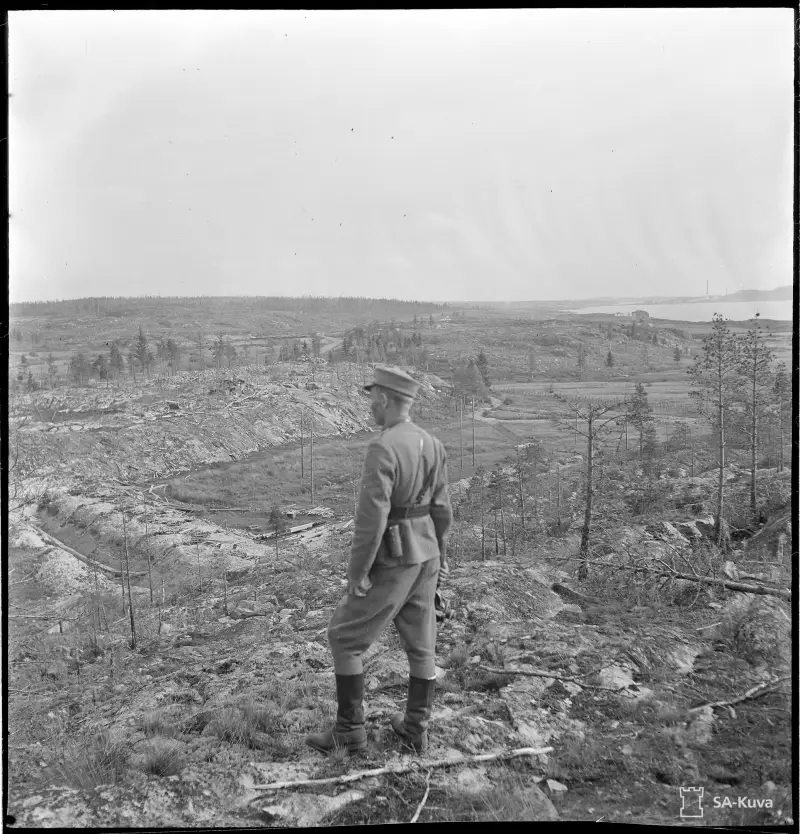
Finnish officer observes the fortifications of the U line
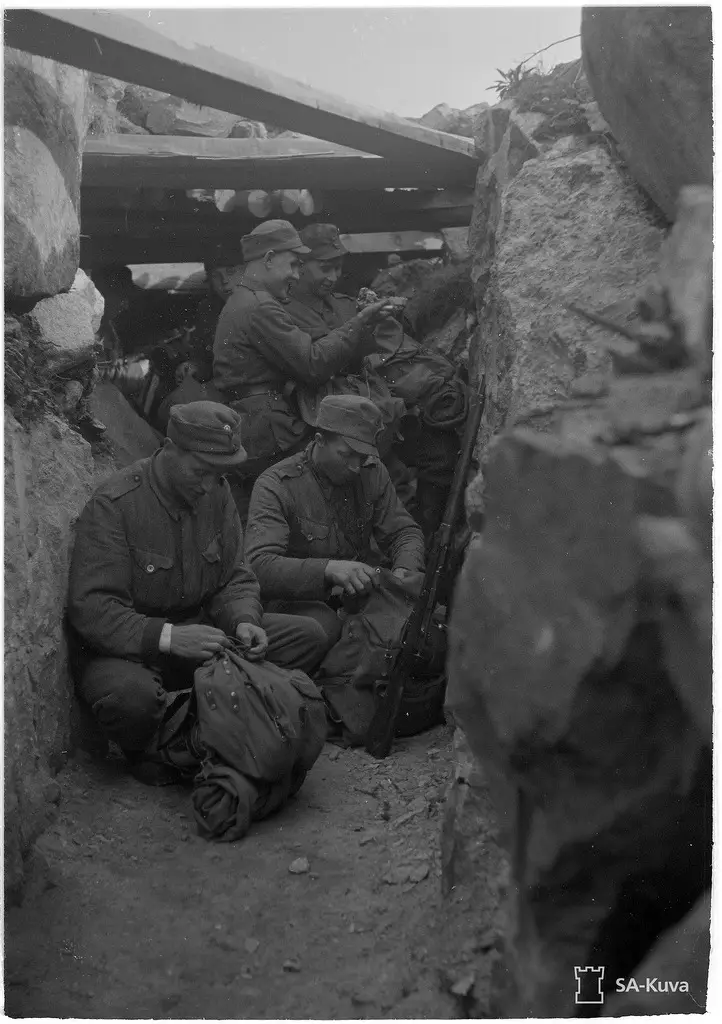
Finnish soldiers in a rock-cut trench
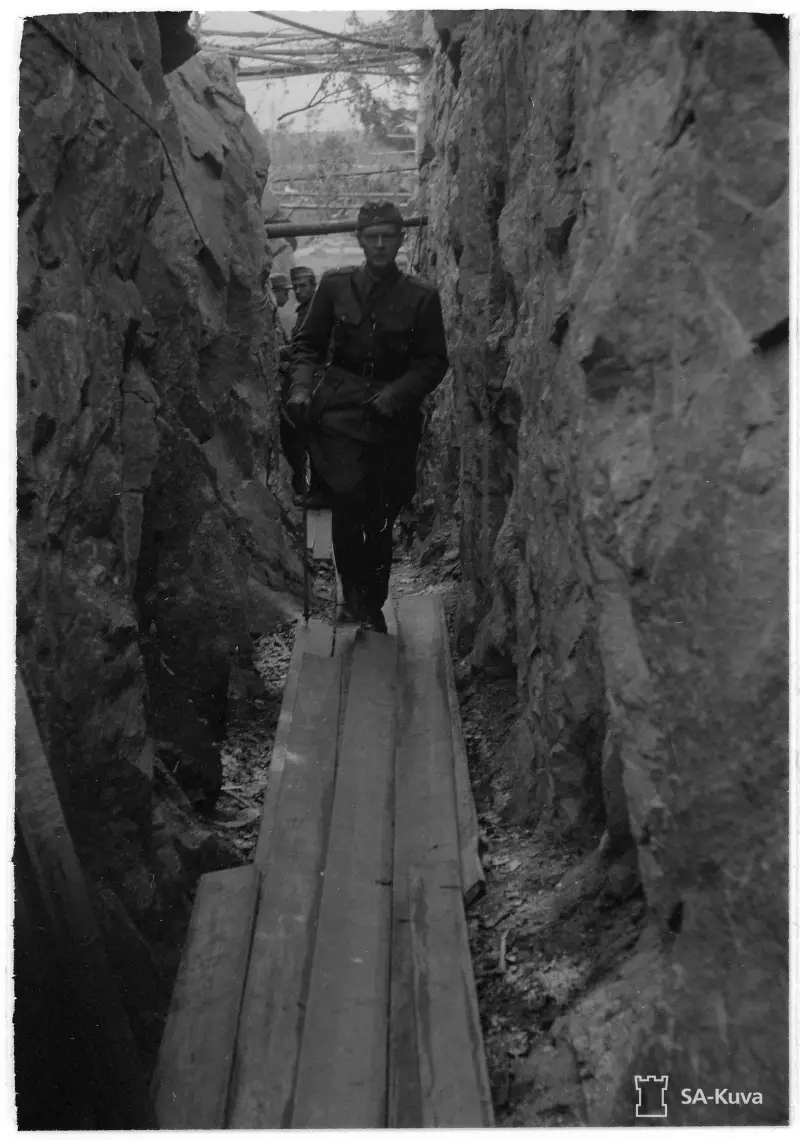
A Finnish officer moves along the path of a message carved into the rock
And then the headquarters of the 7th Army made a huge mistake, deciding that the Finnish 5th and 8th infantry divisions had suffered losses of up to 50% of their personnel, temporarily lost their combat effectiveness and could be withdrawn to the rear to equip a defensive line between the lake. Janisjärvi and Lake Ladoga. Based on these conclusions, the headquarters of the 7th Army gave the order to proceed to the pursuit of the enemy: to the north, along the Kolatselga - Sortavala road, the 127th Light Rifle Corps of Major General G.V. Golovanov moved to the pursuit, to the south, along the coast of Lake Ladoga to Sortavala - 4th Rifle Corps.
There is an underestimation of the enemy, alas, how often have we seen this since... February 24, 2022, against the backdrop of mediocre reconnaissance (it happened that Finnish prisoners, without even being interrogated, were sent to the rear either due to the lack of interpreters, or due to an underestimation of the importance of them information from the command, and information obtained through aerial reconnaissance reached headquarters with a delay), weak interaction between units and branches of the military.
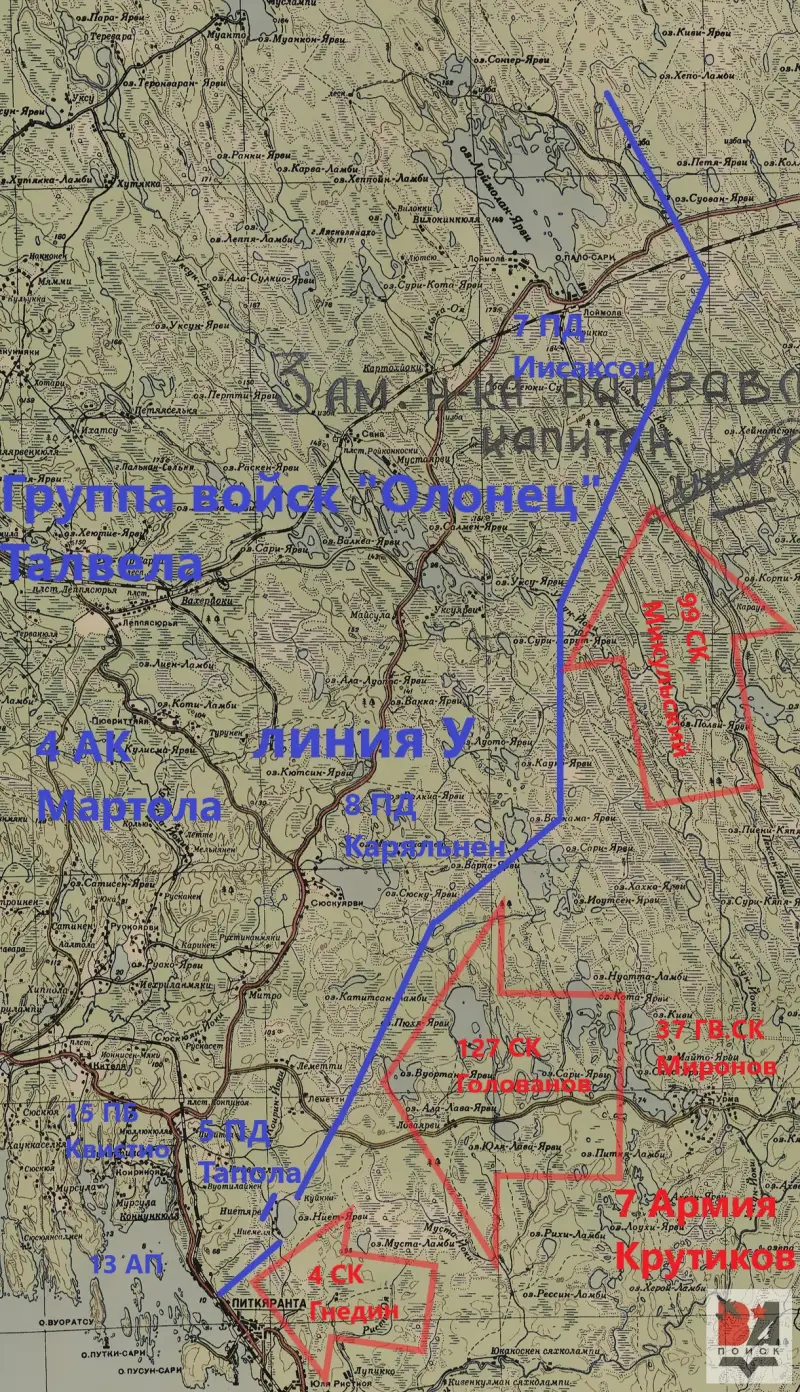
On the night of July 10-11, the troops tried to break through the fortifications of the U line. The unsuccessful attacks of two corps, the total number of which was up to 23 thousand people, lasted two days, after which, making sure that the Finns had a previously prepared defensive line here, the headquarters The 7th Army changed the plan of operation.
By July 13, a new operation plan was presented to the Supreme High Command Headquarters; the Finnish defensive line between Loimola and Lake Ladoga was to be broken through by the 7th Army with the forces of four corps. On the right flank in the direction of Loimola along the road, the main forces of the 99th Rifle Corps of Major General S.P. Mikulsky were advancing. In the direction of the main attack on Kitilya, two corps advanced: from the area of Pitkyaranta along the coastal road to Kitilya and from the area of Lake. Nietjärvi operated the 4th Rifle Corps, to the northeast, along the road to Lemetti - Kitilä - the main striking force of the 7th Army was the 37th Guards Rifle Corps of Lieutenant General P. V. Mironov (paratroopers).
By the way, Lemetti is a notorious place even from the events of the Soviet-Finnish (Winter War) of 1939–1940; it was there that units of the 18th SD and the 34th Light Tank Brigade were surrounded and suffered terrible losses. We already wrote about this in the article “What to do with Finland in NATO”, the specificity of this theater of operations is limited maneuver and critical connection to roads.
The total number of Soviet troops concentrated in a 15-kilometer area between the lake. Vuortanajarvi and Lake Ladoga, reached 45 thousand people. The 127th Light Rifle Corps, which had been commanded by Major General Z.N. Alekseev since July 13 after the injury of Major General G.V. Golovanov, was withdrawn to the second echelon of the strike force, and on July 14 received an order to be transferred to the Loymola direction.
Two infantry divisions of the 6th Army Corps and the 7th Infantry Division, defending in the Loymola direction, were responsible for the defense of the rear defensive line of the U line. The 6th Finnish Infantry Brigade was in the reserve of the 15th Army Corps in the Impilahti area. The 13th Infantry Division of Major General K. Tapol was responsible for the defense of the 5-km section from Lake Ladoga to the area north of Lemetti. On both sides of the road southeast of Lemetti, the defense was occupied by the 2nd Infantry Regiment of Colonel H. Saure, to the right, between the lake. Nietjärvi and Lake Ladoga - 44th Infantry Regiment of Lieutenant Colonel I. Rytkönen.
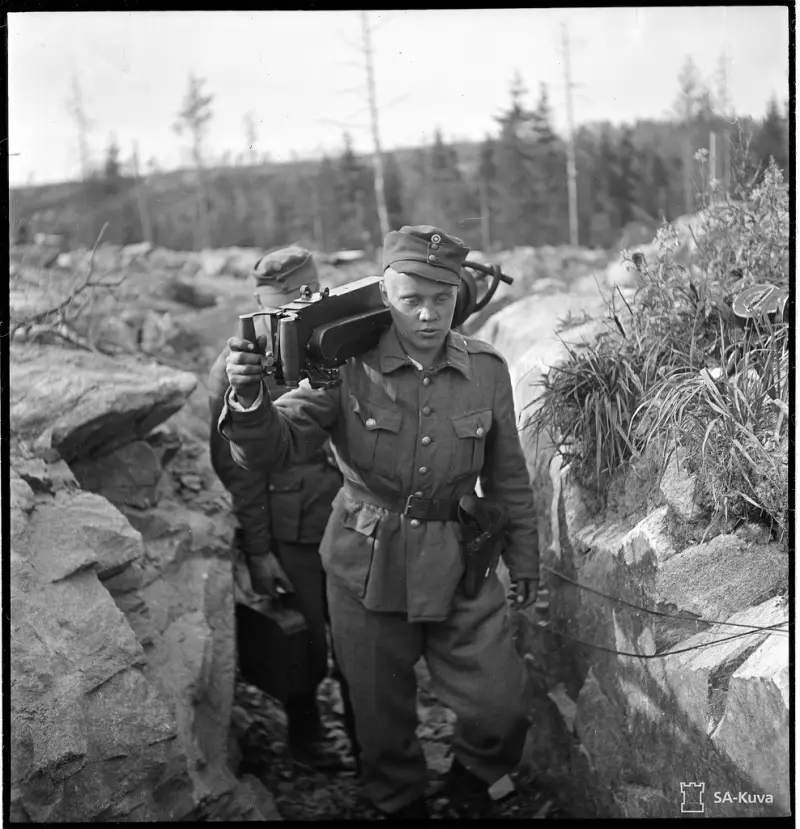
Finnish machine gun crew on line U
The actions of the Finnish troops on the defensive line were supported by a strong artillery group consisting of seven divisions, divided into right and left artillery groups. Between them operated an artillery group of the Olonets group of troops, consisting of four divisions and one battery. Within firing range, the troops from the Impilahti area were also supported by the 13th Coastal Artillery Regiment (some of whose batteries were located on islands in Lake Ladoga). Before the assault on the defensive line began, the Finnish command managed to create a powerful artillery group, target targets, accumulate a sufficient supply of shells, and coordinate the fire maneuver.
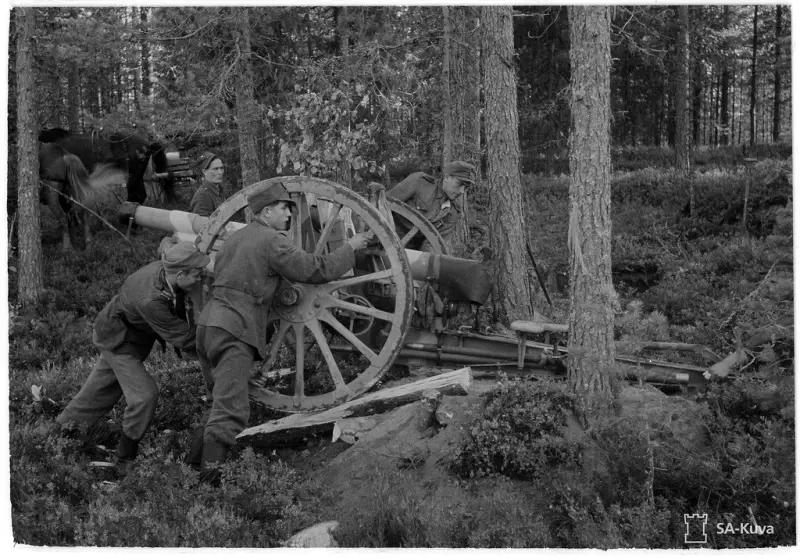
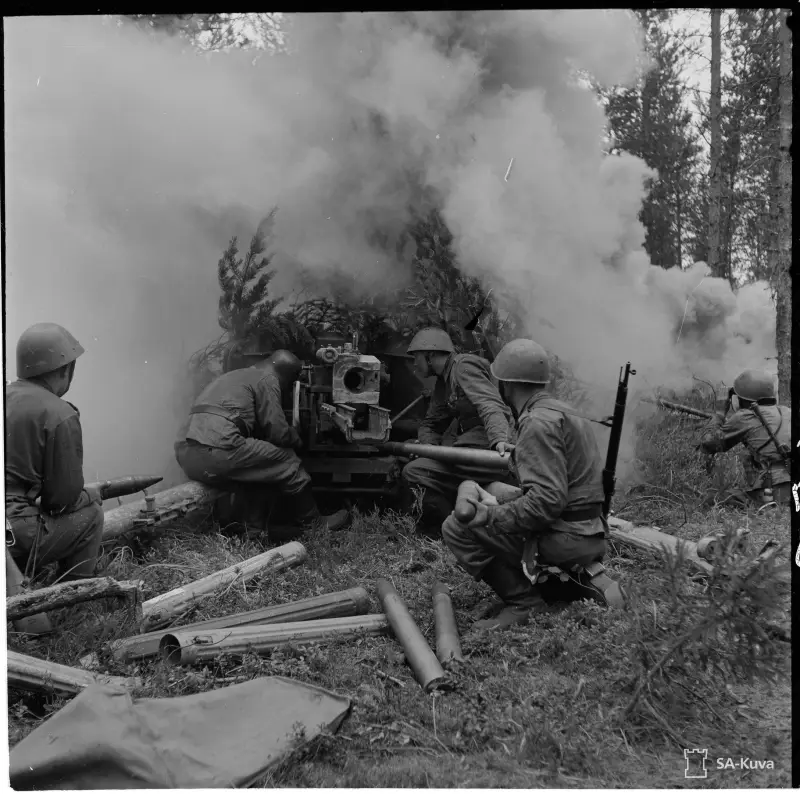
Finnish artillerymen on the U line
In addition, in the defense zone of the 5th Infantry Division, the Finnish command created a strong air defense consisting of nine light anti-aircraft batteries of the 11th Air Defense Regiment (a Finnish armored train also operated there, with powerful air defense). Organization of defense, based on available forces and means, against the enemy - Soviet troops, having both infantry units and a numerically superior number of tanks, self-propelled guns, artillery and solid air cover.
Doesn't remind you of anything? That's it! Everything that the Ukrainian Armed Forces have used and are using to counter our troops. Only instead of numerous MZA batteries - MANPADS, ambushes of air defense systems with external guidance from AWACS, instead of our own aviation drones-bombers and FPV drones, but the basis, like the Finns, is still in the organization of serious interaction (the same “Nettle”), advance preparation, engineering equipment of positions and their camouflage, secrecy of communications and its ubiquity (the enemy is no worse than a steam locomotive , what we achieved on the “Surovikin line”, they will try to repeat and have already repeated in some places, remember the battles near Ugledar) ...
But we digress.
Even before the start of the assault, during the fighting on July 12, the 44th Infantry Regiment left part of the main defensive line in the area of the Niemelya farm on the southwestern shore of Lake. Nietjärvi. As a new section of the main line of defense, the troops set up positions in the area of the Maximoff farm. Behind it, at low altitudes, the last line of defense was prepared, distinguished by the fact that the anti-tank ditch was dug not in front of the trenches, but behind them.
And such a maneuver emphasizes the inadmissibility of ossified views on the organization of defense; the Finns recognized the weak link in their defensive line in time and withdrew their troops from positions in the lowlands between the swamp and the lake to a chain of heights. We must give them their due; subsequent events fully confirmed the wisdom of this decision.
It is gratifying that our command in the Northern Military District is trying to adhere to similar tactics, at least in some directions, when preference is given to controlling the dominant heights rather than populated areas, but in the lowlands.
On July 14, the regrouping of units of the 37th Guards Rifle Corps and the 4th Rifle Corps was completed. Two divisions of the 37th Guards were concentrated on the front between lakes Vuortanajarvi and Nietjärvi: to the right between lakes. Vuortanajarvi and the road to Lemetti - the 99th Guards Regiment of Colonel I. I. Blazhevich, to the left - the 98th Guards Regiment of Colonel K. N. Vindushev, the 299th Guards Regiment of which operated along the road to Lemetti, the 302nd and 296th Guards - between the road and the northeastern shore of the lake. Nietjärvi. The 100th Guards Infantry Division was in the second echelon of the 37th Guards Infantry Division and did not take part in the battles in this sector.
Between Lake Ladoga and lake. Nietjärvi concentrated two divisions of the 4th Rifle Corps: along the western shore of lake. Nietjärvi on Koivuselga was attacked by the 114th Infantry Division of Colonel I.A. Moskalev, to the west, from the area north of the city of Pitkäranta on Koirinoya - the 272nd Infantry Division of Colonel V.M. Meshkov.
The operation plan provided for a quick breakthrough of the enemy’s main defensive line, reaching the isthmus between Lake Ladoga and Lake. Yanisjärvi with the subsequent capture of the city of Sortavala.
At 8:00 on July 15, an artillery barrage began for two hours, after which 123 bombers and attack aircraft of the 7th Air Force launched a powerful air strike. During the entire first day of the assault, Il-2 aircraft, under the cover of fighters, carried out almost 160 sorties to support the troops.
By the way, in our other article “Specifics of search work in modern conditions” we wrote about the recovery of the wreckage of our downed Il-2 from a swamp in the area not far from the U line (by aviation standards), in the appendix there are reports about the losses of pilots from the same regiment, dated exactly to 15.07.1944/XNUMX/XNUMX, Finnish air defense worked very effectively, unfortunately.
After the completion of the artillery preparation, units of the two corps went on the offensive along the entire length of the front. Inaccurate fire from our own artillery to destroy enemy fortifications on the front line, swampy terrain difficult for infantry to pass through with numerous anti-personnel obstacles, rubble and rows of barbed wire, especially in the sector of the 98th Guards Division, powerful and accurate barrage fire from Finnish artillery did not allow the advancing guards units to break through the defenses enemy. On the first day of the offensive operation, the losses of the 98th Guards Division alone exceeded 420 people.
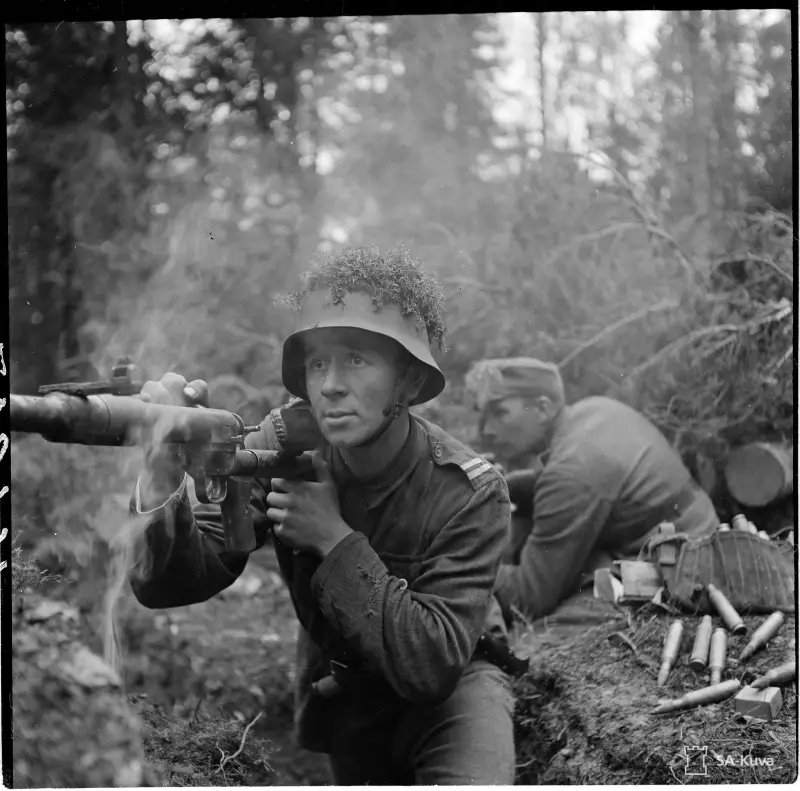
Finnish PTRD crew on line U
By decision of the corps commander, Lieutenant General Mironov, on July 16, active operations in the offensive sector of the 37th Guards Regiment were stopped. The 98th Guards Infantry Division received orders to be ready to exploit the success of its neighbor on the left, the 4th Rifle Corps.
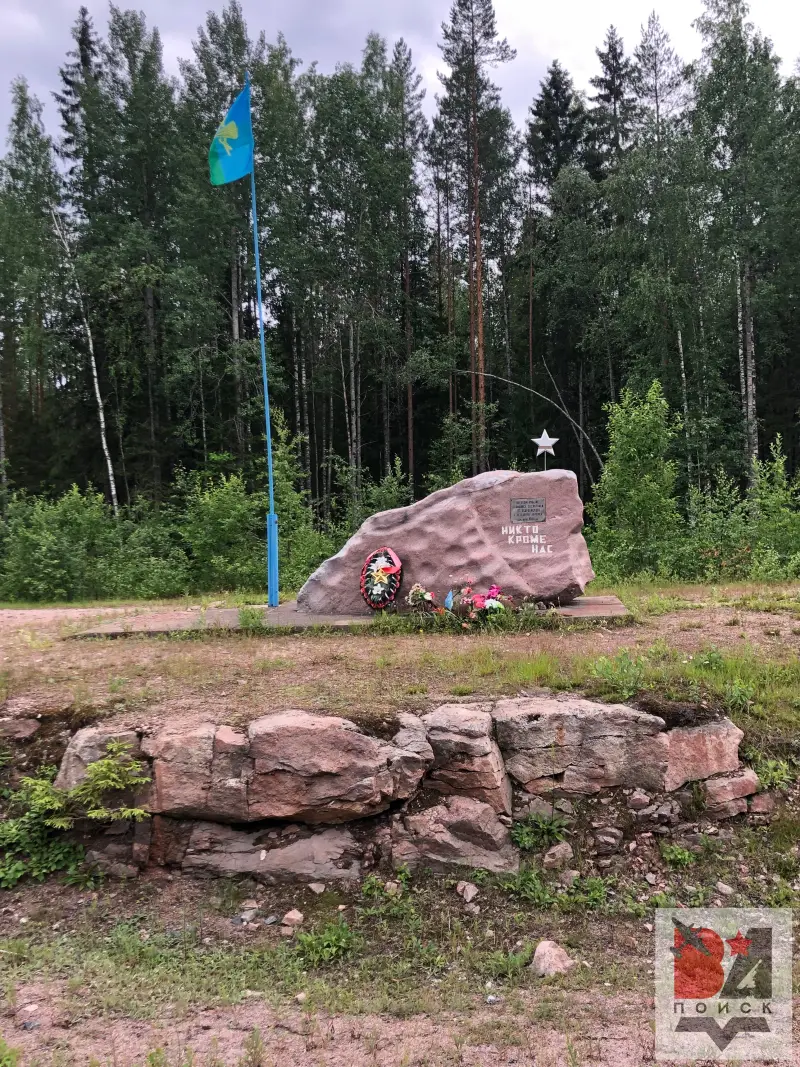
Monument to the paratroopers from the 37th Guards Rifle Corps who stormed the U line
In another sector, on July 15, the 4th Rifle Corps managed to achieve tactical successes in the center and on the right flank. Moving on both sides of the Pitkäranta - Nietjärvi road, two regiments of the 114th Infantry Division broke through the defense line in the area of the Maximoff farmstead and, by 11:00, the last line of defense in the area of the heights northwest of Lake. Nietjärvi. The troops that broke through partly continued their offensive in the direction of Mount Maalammenmäki, and partly along the only road in this area to Koivuselka.
In order to prevent further advance of the enemy, the new commander of the 6th Army Corps, Major General I. Martola, subordinated three battalions of the reserve 5th Infantry Brigade to the 15th Infantry Division. The 4th battalion of the 15th infantry brigade was redeployed to carry out a counterattack from the east against units of the 272nd Infantry Division that had broken through the defense line to the area north of Lake. Nietjärvi.
The 1st battalion of the 15th infantry brigade arrived in the area between Mount Palnutmäki and the village of Nietjärvi to strike from the west. The 44th Infantry Regiment was also reinforced by the 2nd Battalion of the 45th Infantry Regiment of the 8th Infantry Division, which arrived from the reserve of the Olonets Group of Forces. The battalion was given the task of conducting an offensive from the north, from the area of Mount Maalammenmaki.
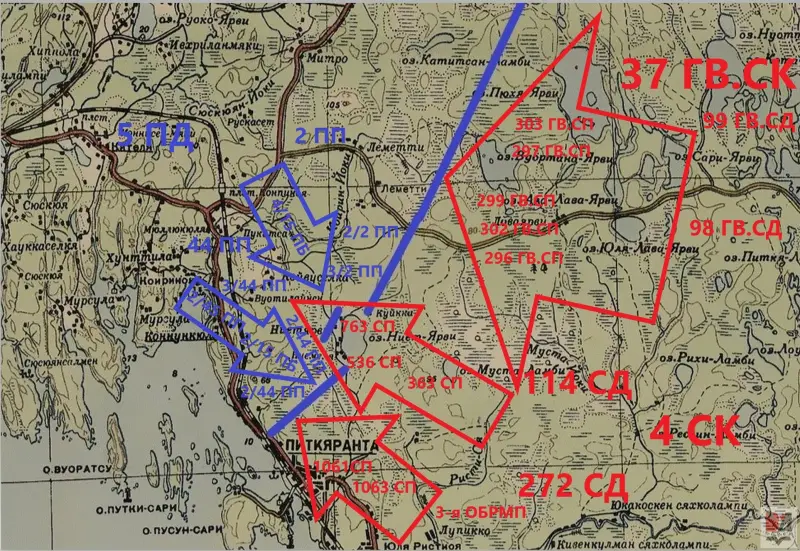
To the left, the 1061st Infantry Regiment of the 272nd Infantry Division managed to break through the enemy's main defensive line west of the Teirisuo swamp. Further advance of the regiment was stopped by enemy counterattacks. According to the headquarters of the 272nd Rifle Division, on the first day of the offensive its total losses amounted to 980 people, including 135 killed and 135 missing. The 1061st Infantry Regiment suffered the greatest losses - 680 people. By the end of the day, the regiment had virtually lost its combat effectiveness.
To carry out a counterattack in the area west of Bol. Teirisuo, in the breakthrough area of the 1061st Infantry Regiment, the headquarters of the 6th Army Corps sent the 1st Battalion of the 15th Infantry Brigade. In cooperation with the 2nd Battalion of the 45th Infantry Regiment, the 1st Battalion of the 15-1st Infantry Brigade defeated the 15st Infantry Regiment on the night of July 16-1061.
Pay attention in the night battle! This speaks, first of all, about the training of the troops and the excellent organization of the battle, but we should be concerned with the maximum provision of the troops participating in the air defense with thermal imagers and night vision devices, including those installed on UAVs.
Fighting in the lake area Nietjärvi 16–17 July 1944
Counterattack of Finnish troops against the main forces of the 763rd and 536th Infantry Regiments, which, after breaking through the main line of enemy defense, occupied positions in a ledge northwest of Lake. Nietjärvi, started at 4:00 on July 16th. The 2nd Battalion of the 45th Infantry Regiment led the attack from the north, the 4th Battalion of the 15th Infantry Brigade from the northeast, and a detachment formed from the 3rd Battalion of the 44th Infantry Regiment from the southwest.
Two Soviet regiments (763rd and 536th regiments) put up stubborn resistance, and by the morning of July 16, numerous attacks by Finnish troops did not lead to results; they failed to block the road from Nietjärvi to Koivuselga and close the encirclement ring from the south. The 114th Infantry Division still controlled the entrance to the ledge up to 400 meters wide between the villages of Yrjölä and Siimes (on map 3 - Yrjölä and Siimes), including having up to 9 tanks here. In the afternoon, Finnish troops resumed the offensive, which also remained ineffective.
The Finnish command decided to change tactics and use assault troops instead of battalions, armed with more automatic weapons. weapons, Faust cartridges, phosphorus hand grenades, Molotov cocktails, grenade clusters and infantry flamethrowers.
I think all readers understand how deadly Faust cartridges and anti-tank grenade launchers become for tanks in such terrain and at such combat distances. And the Finns had them, from their German allies. Analogies with Javelins, NLAW, AT4 simply suggest themselves...
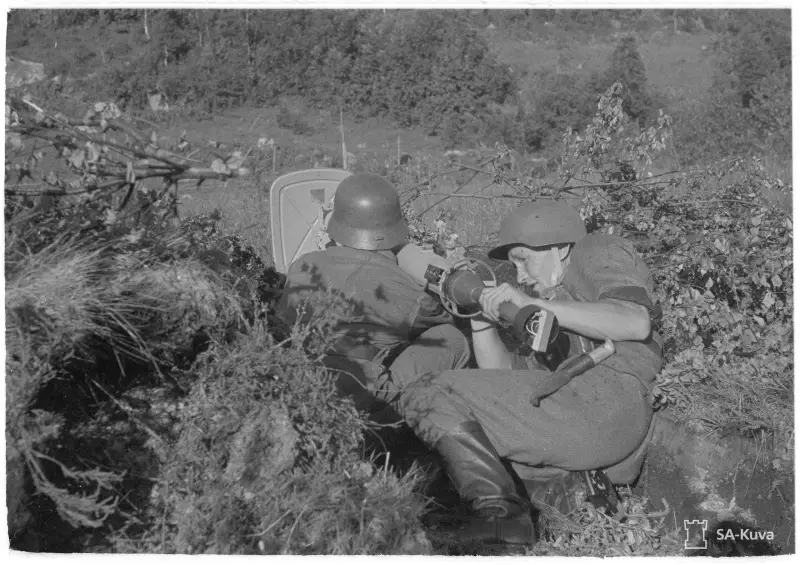
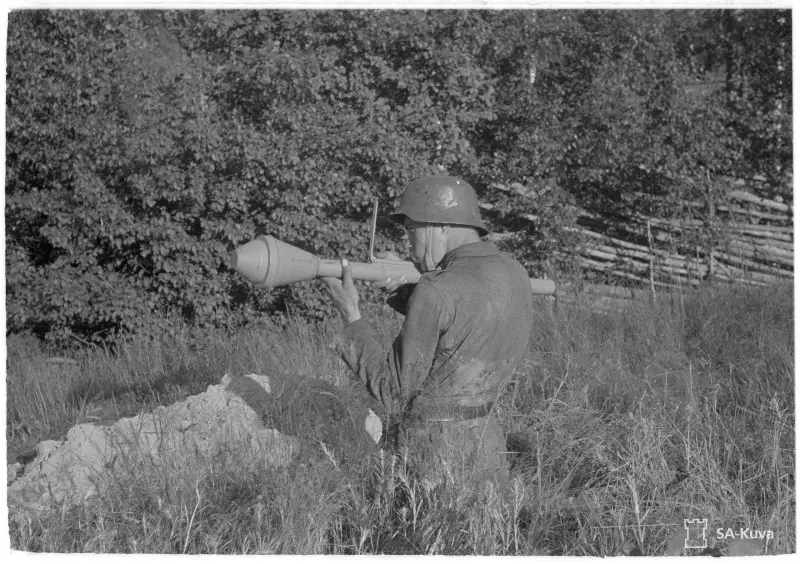
Finnish grenade launchers on line U
Taking into account the active actions of the enemy, the headquarters of the 114th Infantry Division at 10:00 on July 16 ordered the troops to temporarily go on the defensive at the achieved lines. By 16:00, the troops had to dig full-profile trenches and organize a system of barrage artillery fire. On July 16, the 3rd Naval Infantry Brigade was subordinated to the 363rd Infantry Regiment for operations against the Finnish stronghold in the area of Mount Palnutmäki.
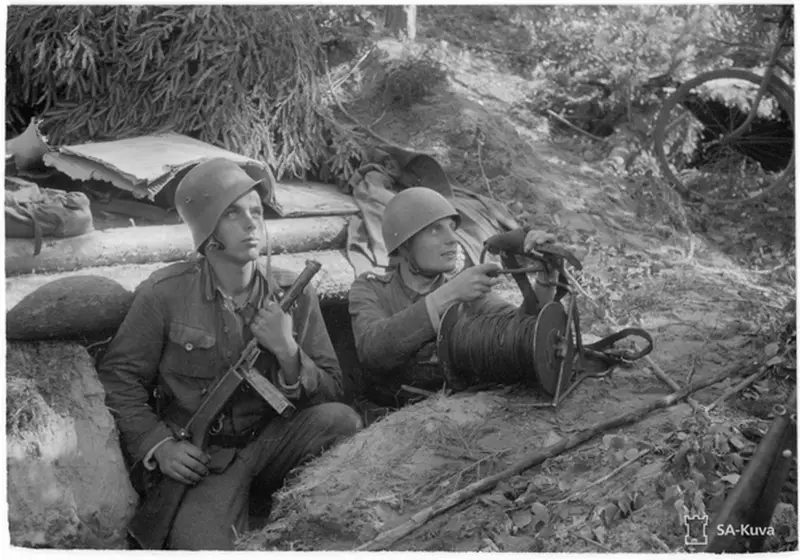
Finnish soldiers at the lake. Nietjärvi, in the hands of one Suomi PP with a box magazine
The decisive offensive of two battalions of the 15th Infantry Brigade (1/15 and 4/pbr) against the base of the salient, which contained units of the 536th and 763rd Infantry Regiments, began at 23:30 on July 16 after artillery preparation. Finnish troops began a long assault, during which the lost and tired units were replaced with fresh ones.
So much for rotation – a popular technique and term these days!
In 1,5 hours, the assault troops managed to advance 150 meters. Only after midnight the assault groups closed the encirclement ring in the area of the Yuriol farm, after which the cleanup began inside the encirclement ring, ending at 9:20 on July 17. Attempts by units of the 1st battalion of the 536th rifle regiment to provide assistance to the encircled 2nd battalion (2/356th rifle regiment) were blocked by Finnish artillery fire, and the 1st company of the battalion (1/356th rifle regiment) moving through open terrain lost up to 80%. personnel.
The outcome of the battle was also influenced by the passive behavior of the right neighbor, the 763rd Infantry Regiment, whose manpower was almost completely destroyed during the battle (report from the headquarters of the 114th Infantry Division). Some of the troops nevertheless managed to escape from the encirclement under the cover of tanks. According to the headquarters of the 114th Infantry Division, on July 17, losses amounted to 494 people. In the battle in the lake area. Nietjärvi July 15–17, the 114th Infantry Division lost its combat capability, with the exception of the 363rd Infantry Regiment.
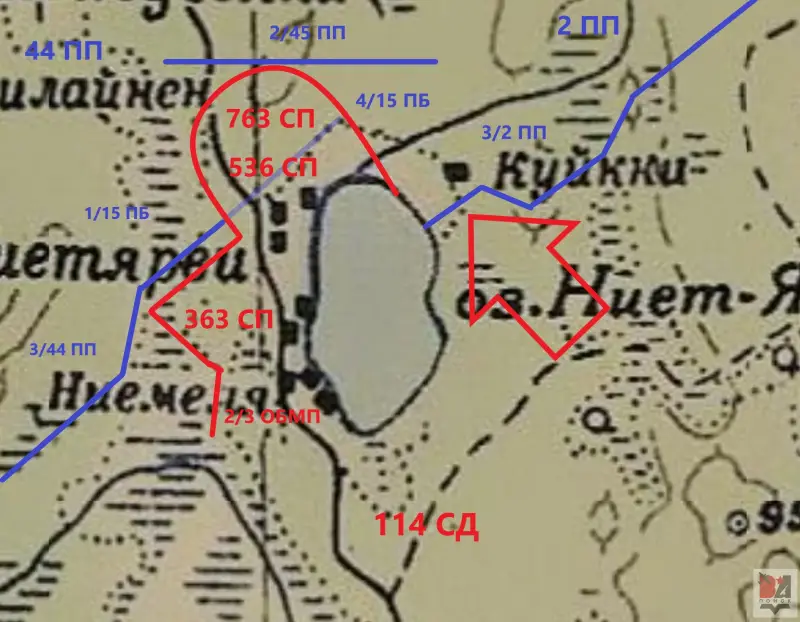
Decisive role in the battle in the lake area. Nietjärvi was played by Finnish artillery.
On July 15 alone, in the sector of the 5th Infantry Division, 11 artillery battalions and one battery of field artillery, the 13th artillery regiment of coastal artillery and mortars fired almost 20 thousand shells and mines at the advancing troops of two Soviet corps - more than on any day the decisive battle on the Karelian Isthmus in the Tali-Ikhantala region from June 25 to July 4, 1944. And here the experience of our ancestors confirms the necessity and importance of high-quality counter-battery work of our artillery in the Northern Military District zone.
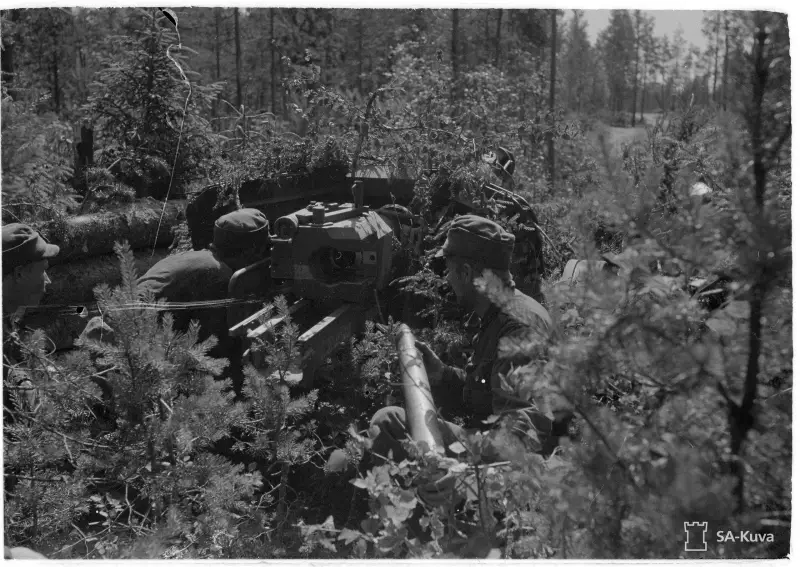
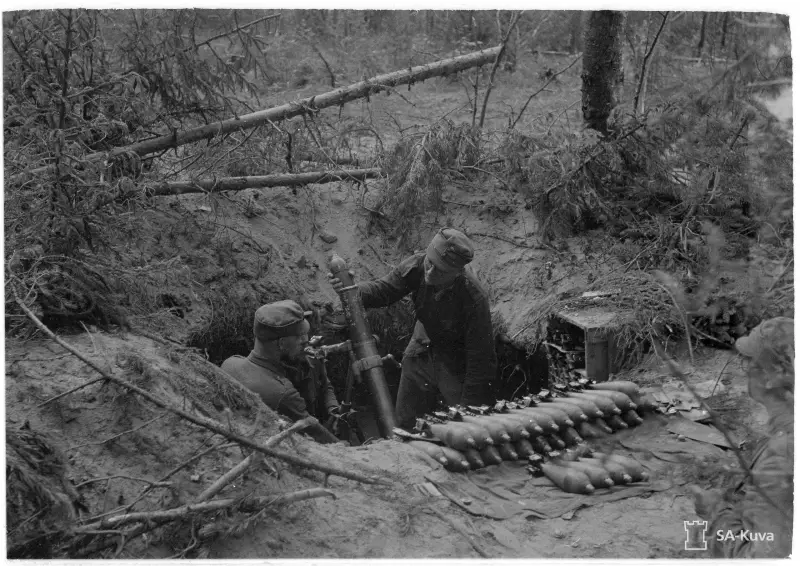
Finnish artillery and mortars near the lake. Nietjärvi
The outcome of the battle in the lake area. Nietjärvi, the loss of combat effectiveness of the 4th Rifle Corps and the reluctance of the Supreme High Command Headquarters to reduce the combat effectiveness of its strike force, the 37th Guards Rifle Corps, the lack of decisive success in the Loymola direction, where the 99th Rifle Corps operated, as well as the lack of prospects for success on the Karelian Isthmus forced The military-political leadership of the USSR finally abandoned the implementation of the original plan: encircling and destroying the main forces of the Finnish army on the Karelian Isthmus and in southern Karelia with limited forces of the Leningrad and Karelian fronts and forcing Finland to unconditional surrender at the initial stage of Operation Bagration.
In the second half of July, secret diplomatic contacts in Stockholm between Soviet and Finnish representatives became more frequent.
On August 2, 1944, the transfer of the main striking force of the Karelian Front, the 37th Guards Corps, began from the front to the reserve of the Supreme Command Headquarters, and already on August 4, K. G. Mannerheim became the President of Finland. Negotiations began on concluding a truce, which ended on September 19 with the signing of the Armistice Agreement.
Conclusions
In our humble opinion, these events, in addition to the historical retrospective, teach us how their knowledge and understanding, with the corresponding conclusions, will allow us to take a more serious look at both the creation of defensive lines and the necessary efforts to storm them.
And to summarize, the main goal of any line of defense is the opportunity to gain time to prepare a counterattack, to cover the withdrawal of one’s units, to hold a line with small forces against a superior enemy, to prepare for resolving issues in the diplomatic field in the end.
The main thing for the defenders is not the amount of reinforced concrete laid in the defensive structures and not the presence of deep trenches (we remind you that the basis of this line of defense, and even such an odious one as the “Mannerheim Line”, was not pillboxes, but a well-thought-out system of fortified points with field structures fortification, the strongest of which was an ordinary machine-gun bunker), but the well-established interaction of well-trained units and units, reliable communications and their comprehensive support with available forces and means, no matter how meager they may be in comparison with the enemy.
For assault units, in addition to the need for thorough reconnaissance, tactical preparation of troops for the assault, organization of interaction, uninterrupted communications, appropriate artillery and aviation training with the obligatory elements of counter-battery warfare, the main thing is also the maximum use of the effect of surprise, even if this requires a diversionary strike.
PS
We apologize that in our work “horses and people were mixed together” - historical events were mixed with current ones, but, as they say, it hurt.
Pss
We express our deep gratitude to Yuri Mikhailovich Kilin, Doctor of Historical Sciences, head of the Department of Foreign History, Political Science and International Relations of the Institute of History, Political and Social Sciences of Petrozavodsk State University for his work on the study of the Great Patriotic War.
Bibliography:
1. Ari Raunio, J. M. Kilin, Jatkosodan torjuntataisteluja 1942–1944. Keuruu, 2008.
2. Reino Arimo "History of the fortification of Finland 1918-1944" (Reino Arimo "Suomen linnoittamisen historia 1918-1944").
3. Mannerheim K. G. "Memoirs".
Information